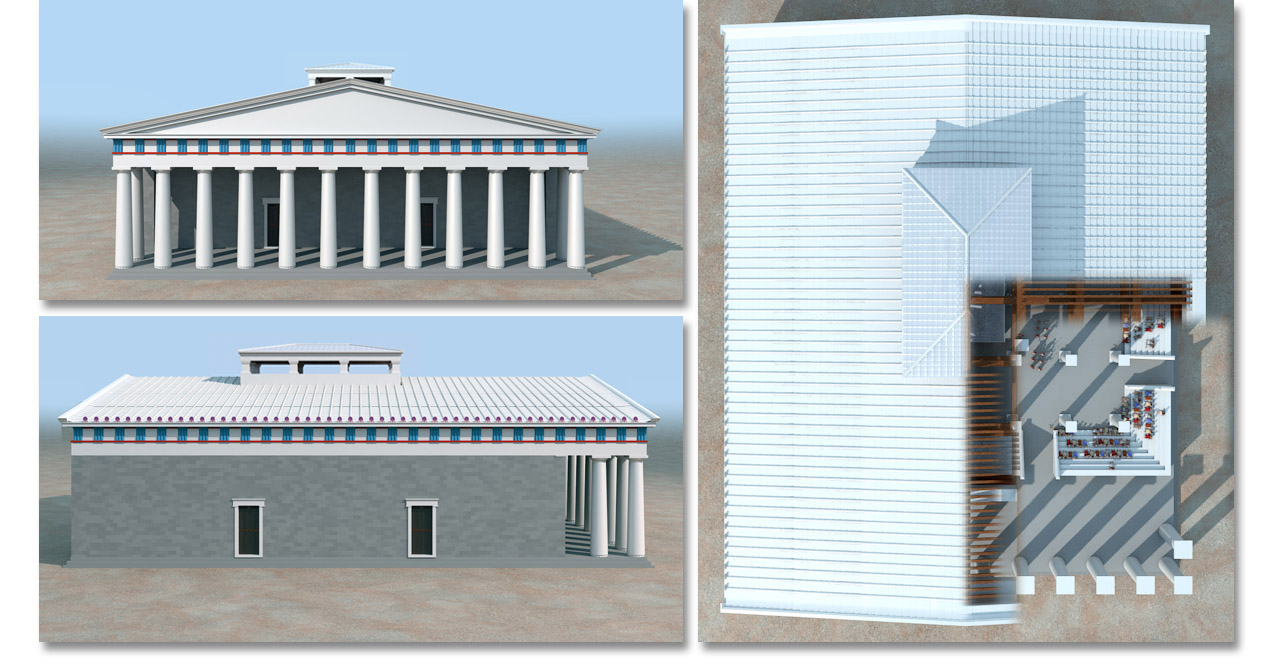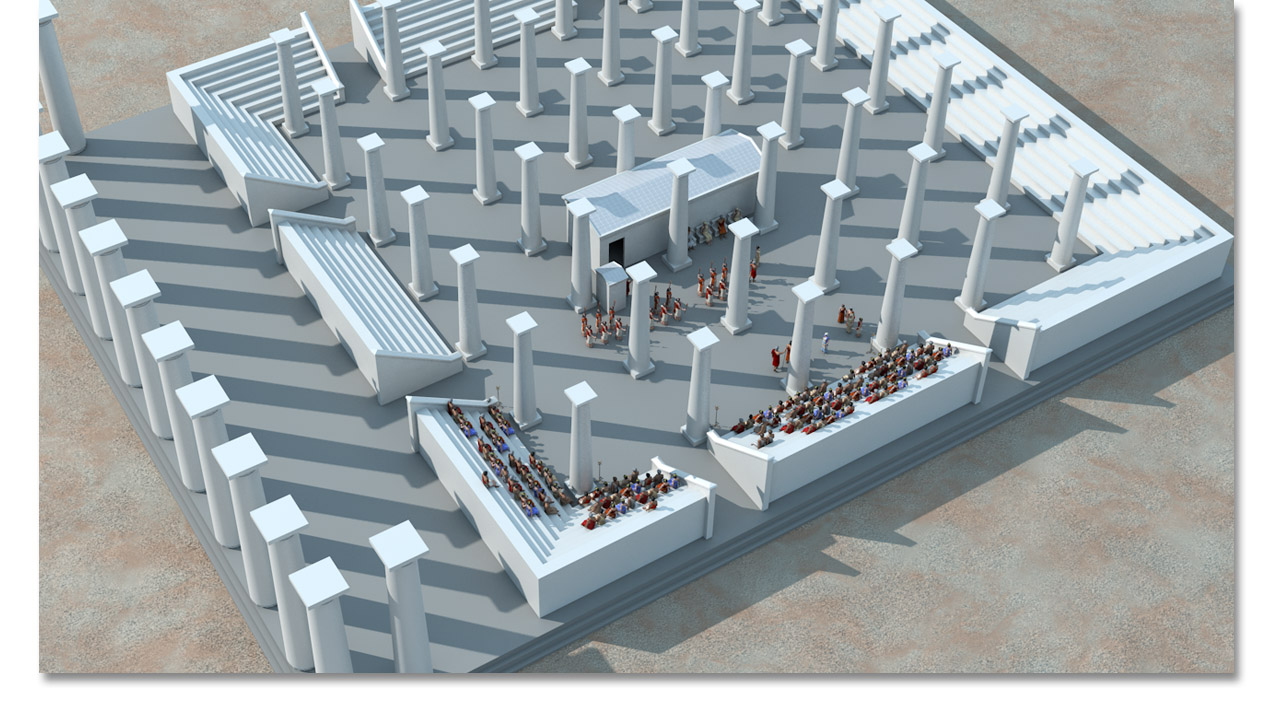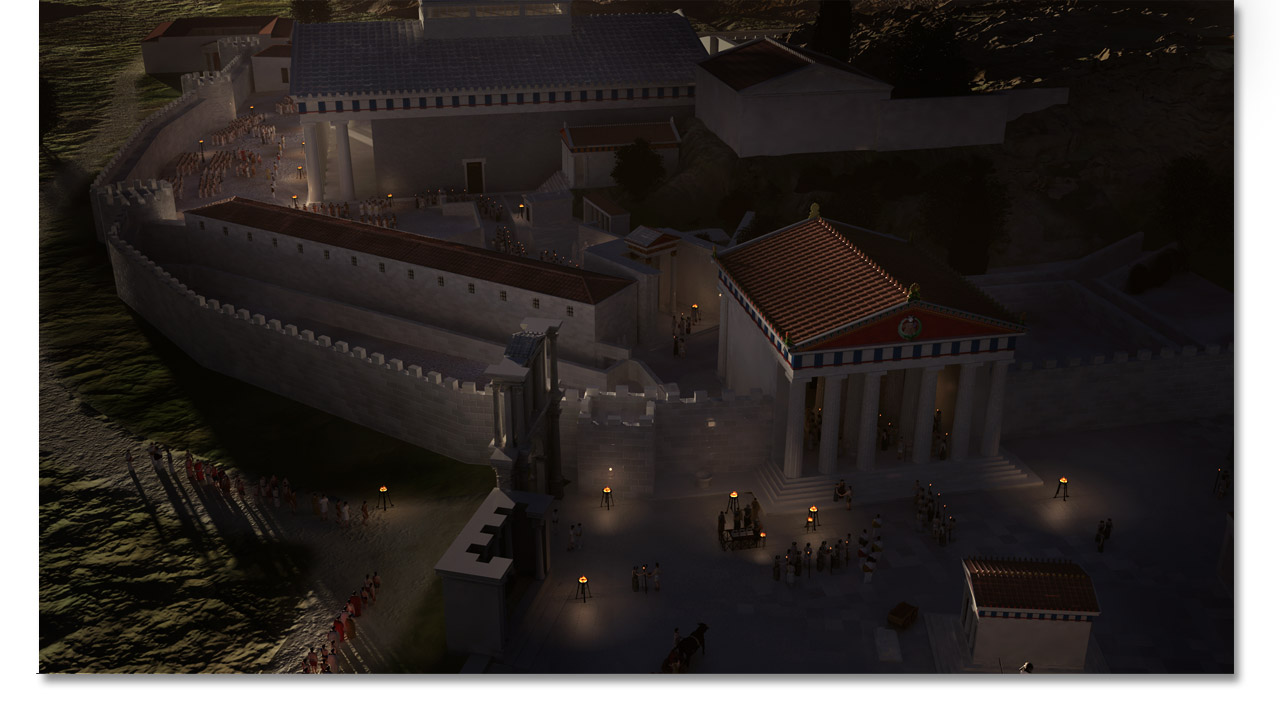ELEUSIS ~ THE INNER EXPERIENCE.
Professor Elena Partida and anasynthesis project leader John Goodinson analyse the architecture and internal layout of the Telesterion.
Numerous studies have been devoted to the Eleusinian mystique. By reconstructing the structural setting, we begin to understand a fraction of what the initiates into the Mysteries experienced. The ruins or, more appropriately, the physical remains are a fair starting point, in order to – even remotely - sense the ambience and the experience.
What would the initiate see, while being inside the Telesterion? By recreating the interior layout of this religious monument – though not a temple - we may notionally be transferred to acts and processes in an intimate sacred locus of the sanctuary at Eleusis. Then the viewer notionally turns into a participant, simply by visualising himself sitting there, in anticipation of sharing an apocalypse.
In this way, a 3D reconstruction of this complex edifice fuels our perception of the scenery, because it offers actual viewpoints within an integral material structure, where anyone is free to place himself and try to unlock the Past.
The Telesterion (above) was a monument of prime importance, where initiation to the Eleusinian Mysteries was performed. The remains visible today on the site belong to successive architectural phases, including the latest one, namely the building’s reconstruction by the Roman emperor. The building is an almost square hypostyle hall, measuring approximately 51.50 metres per side in ground-plan, with a portico added to its eastern facade in the 4th century BC. Two entrances on each lateral side and two along the front provided direct access to the interior. Rows of seating lined the inner face of the walls (interrupted by doorways), whereas the rear wall offered a full-width seating area.
Above: the interior layout of the Telesterion in the 2nd century AD.
The Telesterion was immense and prepossessing already by its architectural design. The roof was supported by 42 columns (six rows of seven columns). Each column carried a tier of smaller ones supporting the ceiling of interconnecting roof beams. The centre of the roof featured an elevated lantern/clerestory, which provided ventilation and light into the Telesterion. One would expect the lantern to have been centred above and axially aligned with the Anaktoron, the small structure of uncertain function that was encapsulated in the Telesterion. However, this was not the case, seeing the off-centre position of the Anaktoron. This detail, along with the columns tightly enclosing the Anaktoron, suggests that the latter pre-existed and probably its sanctity determined its unchanged position throughout the centuries. So, the Telesterion evolved around the Anaktoron, wherein cult objects and sacristies could have been kept until the time of revelation at the culmination of the initiation ceremony. Beside it was the ‘hierophant’s throne’, a sort of canopy to shelter – but mainly to distinguish - the high priest of Demeter.

Above: sectional view revealing the interior and participant seating within.
Our model recreates the Roman phase of the sanctuary, in the 2nd century AD, aiming to offer an inside view. The splendour of the Eleusinian Mysteries appealed to the educated upper-class Romans, with consul Appius Claudius Pulcher undertaking construction in honour of Demeter in the 1st century BC. Philhellene Roman emperors, especially Hadrian (initiated into the Mysteries in AD 125) and the philosopher-emperor Marcus Aurelius, instigated new building programs to ameliorate and expand the sanctuary. The impressive Lesser and Greater Propylaea represent exactly this period of architectural development.
Below: The impressive Lesser Propylaea.
What could be seen inside the Telesterion?
What the initiates were able to see from their seats is very restrictive. The 42 columns supporting the ceiling 'block' your 'line of sight' to a narrow field of vision. Being seated throughout the night would result in a claustrophobic and heightened emotional experience for the participant.
The building’s interior design suggests that the rows of seats evolved like a rectangular cavea around the nucleus of the ceremony, the Anaktoron, reflecting that indeed the rites were open to all. According to Herodotos (Histories 8.65), “anyone who wishes, from all Athens or elsewhere, may be initiated in the mysteries”.
Below: the 'forest of columns' - interior renders (roof removed). The restrictive viewpoint for the seated viewer - concentrating their central peripheral and near peripheral vision.
Nocturnal rites, lit by torches, justify the lantern/clerestory as an air-shaft more than a light-aperture. Likewise, the many entrances served proper ventilation, too. The extensive seating implies wide audiences attending or participating in the things that were said, enacted, and revealed. Whatever the Mysteries comprised (apparitions, re-enactments, ritual performances), it was not a secluded, solitary issue.
Below: interior of the Telesterion with brazier and torch lights in procession.

Every detail of the interior was carefully laid out to magnify the effect of the process. The ‘forest’ of columns, creating the impression of aisles or passages, with the plasticity of their volume set against the delicate transparency of shadows, added to the atmosphere and – together with the darkness and the fragrant burning incense - amplified the impact of the rite. Accomplished inside the Telesterion was a spiritual and cognitive transition, an inner, esoteric process, very intense and formative, whereby people grew wiser, fulfilled, reinvigorated, enlightened. Most probably each of the initiates gleaned the moral that suited their own life and needs. Each individual’s perception was unique and everyone was affected differently by what they witnessed.
In Phaedrus, Plato alludes to the Eleusinian Mysteries: “it is rightly called the most blessed of Mysteries, which we celebrated in a state of perfection, being permitted as initiates to the sight of perfect and simple… and calm and happy apparitions, which we saw in the pure light. Beauty shone in brilliance among those visions.” Astounded by the Mysteries, Cicero states that a shared belief in a better life on earth and hope for an afterlife was imparted to him during his initiation (De Legibus 2.14.36).
“ENTRANCE TO ANOTHER DOMAIN”
SENIOR MOMENTS IN THE SANCTUARY’S DEVELOPMENT
Transition was the key to the Eleusinian ritual and, for the pilgrim who had walked along the length of the processional way, the entrance to the sanctuary was a milestone. Marking the element of transition, the propyla were gateways-termini. At Epidauros and Samothrace, two other renowned mystical sanctuaries, the entrance was likewise monumental. The earliest preserved propylon to the sanctuary of Eleusis, in circa 430 BC, opened out toward the Sacred Way and is thought to have partly inspired the propylaea to the sanctuaries of Demeter Malophoros at Selinous and of Poseidon at Sounion.
Below: The sanctuary in the 2nd century AD.

Probably following a catastrophic flood in Rome, consul Appius Claudius Pulcher vowed to Demeter a sumptuous gift. He kept his promise by erecting (in 50-40 BC) a grandiose marble gateway to the sanctuary of Eleusis, with the site’s symbols carved on the frieze and a pair of Caryatids framing the inner facade. The term “Lesser propylaea” will later distinguish it from the 2nd AD Greater Propylaea, reproducing the design of Mnesicles’ 5th century BC propylaea to the Athenian Acropolis. This was part of the Romans’ overall refurbishing of the entrance area to the sanctuary of Eleusis: the courtyard was paved and a small Doric temple was erected. The Greater Propylaea were started by Emperor Hadrian and completed by Marcus Aurelius, whose sculpted portrait was set in one of the tympana.
The Eleusinian Mysteries of Demeter and Kore at Eleusis
The Sanctuary of Eleusis and the rites of the Eleusinian Mysteries were one of the most important Panhellenic sacred rituals that originated in Greek antiquity and later welcomed into the culture of the Roman world. The Initiation and participation into the Eleusinian Mysteries was open to everyone, regardless of age, sex, social or financial status. All that was required was exemption from having committed the capital crime of murder and the ability to speak and understand Greek.
What happened during the ritual experience of the initiates - perhaps being put into a ‘trance state’. What were the initiates shown? What did they hear? What was done? All re-enacted within the Telesterion at the height of the Eleusinian Mysteries remains unknown.
Above: The sanctuary in the 2nd century AD.
Torchlight procession to the Telesterion.
The actual initiation procedure was never revealed by those who underwent the ritual ceremony. What little we do know is that it was an intense transformative spiritual experience, both deeply affecting and enriching. The ‘initiate’ on completion of the rituals now viewed their life and existence from a new profound perspective.
The Eleusinian mysteries have attracted an endless series of 'theories' based on very fragmentary evidence and the ritual interpretation of the worship and mythology of Demeter and Kore. Ours is a physical reconstruction of the architect’s design of the Telesterion.
As for what the rituals were within - we let the mystery be.
The Mysteries were eventually closed (Theodosius the Great, AD 379- 395) by legislative decrees that outlawed the rites of the ancient religion. The Goths dealt the final blow to Eleusis in AD 396. The Telesterion and sanctuary of Eleusis were destroyed. The priesthood then ceased to exist.
Notes to the reconstruction:
The reconstruction of the sanctuary was based on several publications and articles, including: FERDINAND NOACK, THE ARCHITECTURAL DEVELOPMENT OF THE SANCTUARY: RECORDINGS AND INVESTIGATIONS OF ELEUSIS (1927). DEMOSTHENES GIRAUD, THE MAIN ENTRANCE TO THE SANCTUARY OF DEMETER AT ELEUSIS (Athens 1991) and drawing particularly from JOHN TRAVLOS’ ground-plans and elevations, which reflect the development of the sanctuary from the end of the fourth century BC to the second century AD.